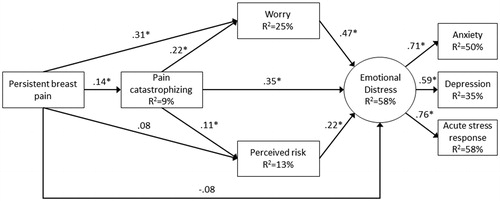Figures & data
Figure 1. Structural equation model for breast cancer survivor group. *p<.05. Persistent breast pain total effect (including direct and indirect effects) = .23, p < .001. Note: Standardized path coefficients are displayed. Analyses included race (0 = non-white, 1 = white), age, BMI, education (0 = no college degree, 1 = college degree or more education), menopausal status (0 = pre/peri menopausal, 1 = post-menopausal), and number of body pain locations (excluding breasts) as covariates. Persistent breast pain group coded as 0 = breast cancer survivor group without persistent pain, 1 = breast cancer survivor group with persistent pain. Direct paths were included in the model from each of the control variables to the emotional distress latent variable and the observed variables for worry, pain catastrophizing, and perceived risk. Disturbance terms were allowed to correlate for the observed anxiety and depression variables, and the anxiety and mammography-distress distress variables.

Table 1. Psychological variables: Comparison of breast cancer survivor group with persistent breast pain, breast cancer survivor group without persistent breast pain, non-cancer group with persistent breast pain, and non-cancer group without persistent breast pain.
